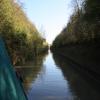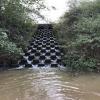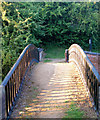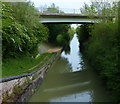
| Wormleighton Reservoir Bridge No 139 | 1 mile, ¼ furlongs | |
| Fenny Compton 'Tunnel' (eastern entrance) | 5¼ furlongs | |
| Fenny Compton Bridge No 138 | 1½ furlongs | |
| Fenny Compton Turnover Bridge No 137A | 1¼ furlongs | |
| Tunnel Bridge No 137 | a few yards | |
| Fenny Compton 'Tunnel' (western entrance) | ||
| Fenny Compton Marina | 3 furlongs | |
| Fenny Compton Wharf | 5¾ furlongs | |
| The Wharf Inn (Fenny Compton) | 6 furlongs | |
| Fenny Compton Bridge No 136 | 6 furlongs | |
| Fenny Compton Bridge No 136A | 6 furlongs | |
Amenities nearby at Fenny Compton Marina
- Oxford Canal Walk - Part One - Oxford to Thrupp - YouTube — associated with Oxford Canal
- A walk along the Oxford Canal (Southern Section) from Oxford to Thrupp Wide
Mouseover for more information or show routes to facility
Nearest water point
In the direction of Napton Junction
In the direction of End of Hythe Bridge Arm
Nearest rubbish disposal
In the direction of Napton Junction
In the direction of End of Hythe Bridge Arm
Nearest chemical toilet disposal
In the direction of Napton Junction
In the direction of End of Hythe Bridge Arm
Nearest place to turn
In the direction of Napton Junction
In the direction of End of Hythe Bridge Arm
Nearest self-operated pump-out
In the direction of Napton Junction
In the direction of End of Hythe Bridge Arm
Nearest boatyard pump-out
In the direction of Napton Junction
In the direction of End of Hythe Bridge Arm
Wikipedia has a page about Fenny Compton 'Tunnel'
Fenny Compton is a village and parish in Warwickshire, England, about eight miles north of Banbury. In 1498 Sir William Cope Who served as Cofferer of the Household of Henry VII from 1494 to 1505. In the absence at that time of a Treasurer of the Household he carried out the duties of that office as well. In 1498 he was granted the Lordships of Wormleighton and Fenny Compton, part of the lands of Simon de Montford who had been attainted in 1495. He later sold the lands to the Spencer family, later of Althorp.
In the 2001 census the parish had a population of 797, increasing to 808 at the 2011 census. Its name comes from the Anglo-Saxon Fennig Cumbtūn meaning "marshy farmstead in a valley".
The Parish church of St. Peter and St. Clare was built in the 14th century and is a Grade II* listed building.
The village has a doctor's consulting-room, a small Co-op Food store, a popular local pub located centrally and another pub on the outskirts. The old part of the village has many notable buildings including the Woad House, Knotts Cottage, the Red House, the Old School House and the Hollies.
Fenny Compton is small but had two stations, Fenny Compton on the Great Western Railway route from Oxford to Birmingham, and Fenny Compton West on the Stratford-upon-Avon and Midland Junction Railway route from Bicester to Broom. The GWR station and SMJ station were built alongside each other controlled by a joint signal box.
The Fenny Compton Railway Station (Great Western from Birmingham to London and the LMS branch line from Stratford Upon Avon to Blisworth) closed in 1964 apart from the railway line from Fenny Compton to CAD Kineton.
The village was struck by an F0/T1 tornado on 23 November 1981, as part of the record-breaking nationwide tornado outbreak on that day.
































